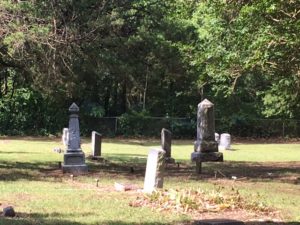
Bethel Cemetery – This photo shows part of the cemetery where a young girl frequently went while sleepwalking. At the time Bethel schoolhouse and Bethel Methodist Church were located across the road south of the hamlet of Neola.
Drive down State Highway 34 to the traffic light at FM 1570; turn left and in a short time you will be on the north side of the hamlet of Neola. Actually Edgewood Drive marks the entrance to Neola. James Willis Devenport (sometimes spelled Davenport or Devanport) owned the town, named it for some unknown woman, and served as postmaster while the post office was located in one of his buildings.
After the Civil War when cotton became the premium crop in Hunt County about 100 such villages popped up at crossroads. Neola exemplified such communities. Devenport owned a large two-story frame building with two rooms downstairs and a large meeting room for the Woodmen of the World on the second floor. One of the downstairs rooms was a grocery store and the other sold dry goods. The Woodmen of the World Camp # 1088 originated in the building in 1881, giving us a good date to use in determining the heyday of Neola.
Devenport also owned the local cotton gin. Barbara and James Horan’s mother Mary told that her home on the corner of Timberside and 1570 was the site of the gin pool. The pool was vital to the gin as it held water used for steam production.
Motor south on Timberside Drive to the Independent Order of Odd Fellows (IOOF) Park set among towering trees that still stand amid homes. A bandstand, campground with fire pit, and picnic tables provided entertainment a five-acre space during the yearly summer picnic. The annual picnic was not held on July 4, as Southerners at that time did not honor that day as a holiday.
The late Don Hayter who owned the last original home in Neola told me that Edgewood Drive was the main street. Homes and buildings sat on the south side. In addition to the cotton gin, two blacksmiths and a gristmill operated in the little town. Peter Inabinette was one of the blacksmiths. South of the village was Mount Bethel Methodist Church, school, and cemetery. Today all that is left is the cemetery, but the school was moved across Highway 34 several years ago. Today it is a Community Center.
Don once told me about a young girl who kept having strange dreams. One morning she told her parents how many tombstones were in the Mt. Bethel Cemetery. When the family counted, she was correct. They began to watch her; she suffered from sleepwalking.
Little is known about James Willis Devenport before the Civil War. He served in the 1st Indian-Texas Regiment, sometimes called the 13th or 22nd Stevens Regiment, CSA. His papers show he enlisted on December 15, 1861 and started out in a cavalry unit that was dismounted. He kept his horse and saddle, though. Returning home unharmed, Devenport traded both horse and saddle for 640 acres of prime farmland. Today a vast majority of those 640 acres lie inside the fence at L-3. Not a bad deal for an old warhorse.
